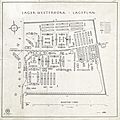Westerbork concentration camp facts for kids
Westerbork was a special camp located in Drenthe, a province in the Netherlands. It was first built before World War II to help Jewish people who were escaping from Germany. However, during the war, it was taken over by the Nazis. They used it as a "transit camp," which means it was a place where people were held temporarily before being sent to other, much worse camps.
Contents
What Was Westerbork?
Westerbork was not like a regular prison. It was a concentration camp, which was a type of camp where the Nazis held people against their will. These people were often targeted because of their religion, background, or political beliefs. The Nazis used these camps to control and persecute millions of people, especially Jewish people, during World War II.
Early Days: A Refugee Camp
Westerbork was originally built in 1939 by the Dutch government. Its first purpose was to house Jewish refugees who had fled from Nazi Germany. These people were seeking safety in the Netherlands. The camp was meant to be a temporary home for them.
Under Nazi Control: A Transit Camp
In 1942, during World War II, the Nazis took control of Westerbork. They changed its purpose completely. Instead of being a safe haven, it became a transit camp. This meant that people, mostly Jewish people from the Netherlands, were brought to Westerbork. From there, they were put on trains and sent to larger, more deadly concentration and extermination camps in places like Poland and Germany.
Who Was Sent to Westerbork?
Most of the people sent to Westerbork were Jewish. However, the Nazis also imprisoned other groups there. These included Roma and Sinti (often called "Gypsies"), members of the Dutch resistance who fought against the Nazis, and even some Allied airmen whose planes had crashed.
Life Inside the Camp
Life in Westerbork was very difficult. People lived in crowded barracks, which were simple buildings with many bunk beds. They had limited food and poor sanitation. Even though it was a transit camp, some people stayed there for weeks, months, or even years before being deported. To keep people busy and to help run the camp, the Nazis forced many prisoners to work. This work included building things, doing chores, or working in small factories within the camp.
Deportations from Westerbork
The main purpose of Westerbork under the Nazis was to organize deportations. Every Tuesday, trains would leave Westerbork, packed with people. These trains went to camps like Auschwitz-Birkenau, Sobibor, Bergen-Belsen, and Theresienstadt. More than 100,000 people were deported from Westerbork during the war. Very few of them survived.
Liberation and Aftermath
Westerbork was liberated, or freed, by Canadian soldiers on April 12, 1945. When the soldiers arrived, they found about 900 people still alive in the camp. These were mostly people who had been too sick to be deported or who were working in essential roles.
What Happened to the Camp After the War?
After World War II, Westerbork was used for different purposes. For a while, it held Dutch people who were accused of working with the Nazis. Later, it became a camp for people returning from Indonesia, which was a former Dutch colony.
Westerbork Today: A Memorial Site
Today, the site of Camp Westerbork is a memorial and a museum. It serves as a reminder of the terrible events that happened there during World War II. Visitors can see the remains of the camp, including foundations of barracks and the old railway line. There are also monuments and an information center that tell the stories of the people who were imprisoned there. It is a place for learning about history and remembering the victims.
Images for kids
See also
 In Spanish: Campo de concentración de Westerbork para niños
In Spanish: Campo de concentración de Westerbork para niños



